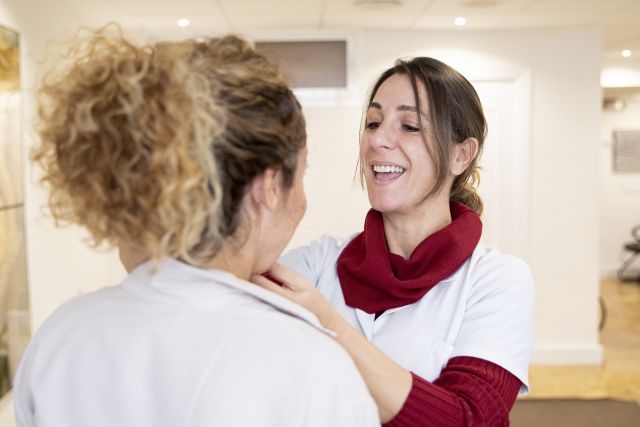Updated on March 28, 2024.
Nearly 50 million Americans have a disorder that affects communication, language, or hearing, according to the American Speech-Language-Hearing Association. A speech disorder, specifically, occurs when someone has trouble producing sounds to communicate. These fall into three main categories:
- Articulation disorders happen when irregular movement of lips, tongue, or throat interfere with individual speech sounds
- Voice disorders are characterized by issues with vocal pitch, volume, or other qualities
- Fluency disorders involve pauses, repeated sounds, and other problems with speech flow
For some people, speech disorders fade away before adulthood. For others, they are permanent. The following are among the most common speech disorders in the United States, for both children and adults.
Stuttering
Sometimes referred to as stammering or disfluent speech, stuttering is considered to be a fluency disorder. About 79 million people around the world stutter, according to the National Stuttering Foundation.
Symptoms: Stuttering involves repetition, prolongation, and interruption while speaking. This means a person who stutters may:
- Repeat a word’s first syllable
- Repeat single-syllable words
- Draw out sounds or syllables, or hold them for too long
- Pause in the middle of words
- Block, or form pauses that are silent or have a sound like “um”
- Switch to a different word than originally intended to stop a stutter
- Overstress a particular part of a word or a whole word
Stuttering can also affect movements. It might cause spasms in muscles in the face, neck, arms, and shoulders. Habitual gestures like blinking or fist-clenching may happen with the stuttering, as well.
Being tired or stressed can make symptoms worse, whereas being well rested and feeling relaxed can improve symptoms. For some people, stuttering may not happen while singing or reading out loud.
Causes: The causes of stuttering aren’t fully understood, but family history and genetics play a role. You are three times more likely to stutter if a parent or sibling stutters. People who stutter may also have differences in structures in the brain that control speech.
Treatments: For both children and adults, speech therapy is the primary form of treatment. Speech-language pathologists work to find exercises that help with speech fluency. They also focus on helping people feel less anxious about speaking.
For kids, speech therapy often centers on play, such as playing board games based around language. For adults, speech therapy tends to focus on exercises that improve the way the brain and mouth work together.
Electronic devices may also help. Different tools can help a person slow their speech or help them feel like they’re speaking in unison with someone. Cognitive behavioral therapy (CBT) may help someone get past mental blocks and ways of thinking that can worsen stuttering, too.
Dysarthria
Dysarthria is a motor speech disorder in which people have difficulty expressing certain words because of weakness in the muscles in the tongue, mouth, and/or vocal cords.
Symptoms: People with dysarthria understand others and know what they themselves would like to say. But they have trouble speaking, or moving their lips, jaw, and tongue. Symptoms include:
- Slurred speech
- Mumbling or lack of articulation
- Lack of control over the loudness or softness of speech
- Sounding hoarse, nasal, or monotone
- Tending to speak in brief, quick bursts with pauses
- Dysphagia, or difficulty swallowing
Causes: Dysarthria is caused by damage to the brain or nervous system. This damage might happen before birth, or it might be due to a traumatic brain injury, stroke, or tumor. It may also happen as a symptom of a separate condition, like Parkinson’s disease or multiple sclerosis (MS).
Treatments: A speech-language pathologist will recommend treatment based on the severity of the condition, with special attention paid to:
- Strengthening muscles involved in speech
- Strategies for speaking loudly
- Using slower speech to speak more clearly
- Intentionally using particular muscles to help with speech
- Communicating nonverbally, through writing or gestures
A speech-language pathologist may also help the loved ones of the person with dysarthria learn strategies for communicating, like reducing ambient noise, ensuring good lighting, and asking yes/no questions.
Articulation disorder
Having an articulation disorder means you have trouble making speech sounds due to movement issues with the throat, tongue, and/or lips. Articulation disorders usually occur in children.
Symptoms: Someone with an articulation disorder might substitute sounds (such as saying “fum” instead of “thumb”) or leave them out altogether. They may also add new sounds, or sounds might come out in a distorted way, sometimes making them more difficult to understand.
Lisping is one example of an articulation disorder. People with a lisp have a difficult time pronouncing “S” and “Z,” because their tongue is misplaced during speech.
Causes: Children are more likely to have articulation disorders if there is a family history, or if their mother had complications during pregnancy or delivery. For reasons that aren’t yet understood, they occur more in boys than girls.
Adults with articulation disorders often developed them as children, and then went without treatment. Stroke and traumatic brain injury are other common causes.
Treatment: Speech therapy is the best treatment for articulation disorder. Exercises will work on identifying and correcting sounds, re-learning oral movements and lip shapes, and strengthening speech muscles.
Spasmodic dysphonia (laryngeal dystonia)
Approximately 100,000 people in the United States are affected by spasmodic dysphonia, also known as laryngeal dystonia. It’s a condition in which the voice box spasms, causing the voice to change. There are three types of spasmodic dysphonia: adductor, abductor, and mixed.
Symptoms: Though a shaky voice, known as vocal tremor, is common to all types of spasmodic dysphonia, other symptoms can vary.
- Adductor spasmodic dysphonia, the most common type, can make a person’s voice sound tight, hoarse, or strained.
- Abductor spasmodic dysphonia causes the voice to be very breathy or produce no sound at all.
- Mixed spasmodic dysphonia is rare, but it can cause a combination of symptoms of both the adductor and abductor types.
Causes: Though the exact causes are not fully understood, experts understand spasmodic dysphonia is fundamentally a neurological issue. It may have to do with the basal ganglia, a part of the brain that helps coordinate the ways the body moves.
Treatments: There’s no cure for this speech disorder. But there are treatment options to help manage symptoms, including:
- Voice therapy
- Assistive technology, such as apps and computer programs that translate typed text into speech
- Botulinum toxin injections, which weaken muscles of the larynx and help protect the vocal cords
- Laryngeal adductor denervation-reinnervation (SLAD-R), a surgery that works by disconnecting and reconnecting nerves that bridge the vocal cords and brain
Other disorders
Some disorders that affect speech are temporary and caused by illnesses or behaviors. For example:
- Hoarseness may be caused by the flu or a cold, or from shouting, singing, or talking too much.
- Laryngitis, or swelling in the voice box, is usually the result of allergies or an infection.
- Vocal cord lesions, such as benign structural issues like polyps and nodules, can also affect the voice.
If you have symptoms of a speech or voice disorder, it’s important to be evaluated by a healthcare provider. They’ll help you identify the cause, establish a diagnosis, and can rule out other, serious causes that might be behind vocal or speech issues, such as Parkinson’s disease, cancer, or multiple sclerosis. They’ll also help you find treatments to help you manage your symptoms.







